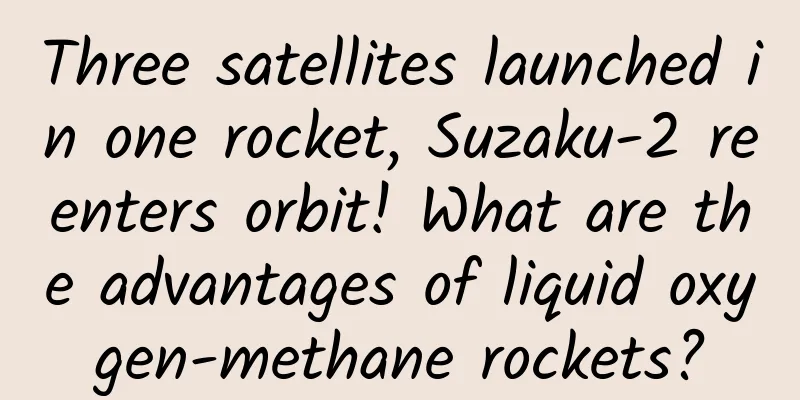Three satellites launched in one rocket, Suzaku-2 reenters orbit! What are the advantages of liquid oxygen-methane rockets?

|
At 07:39 on December 9, 2023, Beijing time, the Suzaku-2 Y3 carrier rocket was launched from the Jiuquan Satellite Launch Center in my country, successfully sending the Honghu satellite, Tianyi 33 satellite and Honghu-2 satellite into the planned orbit. This mission is the third flight of the Suzaku-2 carrier rocket. (Image source: Our Space) The successful completion of the "three satellites in one rocket" commercial launch mission marks that the technical maturity and stability of Zhuque-2, the world's first liquid oxygen-methane carrier rocket that has been successfully launched continuously, have been further verified, and its reliability has reached the requirements for commercial launch delivery. Blue Arrow Aerospace has also become the first company in China's civilian and commercial aerospace industry to successfully launch medium and large liquid carrier rockets continuously, and has taken the lead in opening a new stage of large-scale commercial launches of domestic mainstream liquid rockets. (Photo source: Landspace) What kind of rocket is Suzaku-2? Zhuque-2 is my country's first medium-sized liquid rocket using liquid oxygen and methane as propellants. It has independent intellectual property rights and is committed to providing customers with low-cost, highly reliable launch services to meet the needs of commercial launches in multiple scenarios. The total length of the rocket is 49.5m, the diameter of the rocket body is 3.35m, the takeoff mass is 220 tons (excluding payload), and the takeoff thrust is 268 tons. The first stage of the rocket uses four Tianque 80-ton liquid oxygen-methane engines in parallel, and the second stage uses a combination of a Tianque 80-ton liquid oxygen-methane engine and a Tianque 10-ton swimming liquid oxygen-methane engine. The carrying capacity is 1.5 tons in a 500km sun-synchronous orbit, and the subsequent improved version can reach a carrying capacity of 4 tons in a 500km sun-synchronous orbit, which can meet the needs of low-Earth orbit satellite deployment and spacecraft launch. Previously, the Zhuque-2 Yao-2 rocket was launched on July 12, 2023, and won the title of the world's first liquid oxygen-methane rocket to successfully enter orbit, filling the gap in my country's liquid oxygen-methane rocket technology route. (Photo source: Landspace) This time, the Zhuque-2 Yao-3 rocket successfully sent the Honghu satellite and Tianyi 33 satellite developed by Tianyi Research Institute, and the Honghu-2 satellite developed by Hongqing Technology into a 460km sun-synchronous orbit. This is the first time that this type of rocket has successfully carried out a commercial launch mission of multiple satellites with one rocket, which represents the steady progress made by Blue Arrow Aerospace in building its commercial operation capabilities. For launch vehicles, liquid fuel is king With a height of 49.5 meters and a takeoff mass of 219 tons, the Zhuque-2, as a medium-sized carrier rocket, may not seem to have many impressive features at first glance. But in fact, the Zhuque-2 is definitely a groundbreaking product in the domestic and international commercial aerospace industry. (Image source: Our Sky) First of all, the successful launch of the Suzaku-2 Yao-2 rocket itself set a world record: it is the world's first liquid oxygen-methane carrier rocket successfully launched into orbit. Note the key words here: "liquid oxygen-methane", which starts with the "Tianque" series rocket engine that provides powerful power for the Suzaku-2. In principle, a rocket is actually a power device that uses the propellant it carries to react and generate a high-speed jet of hot air for propulsion. For launch vehicles whose main mission is space transportation, there are four mainstream propellant options for their engines: solid fuel, nitrogen tetroxide/undimethylhydrazine, liquid oxygen-kerosene, and liquid oxygen-liquid hydrogen. The first is the solid propellant option, which should be considered the oldest rocket fuel. The primitive rockets that used black powder as fuel in ancient times belong to a type of solid rocket. The advantages of this propellant are easy long-term storage, ability to respond to emergencies, and simple technology. But the shortcomings are also very obvious, such as small specific impulse and non-adjustable thrust. Here we are talking about a key concept: specific impulse, which is the impulse generated by a unit amount of propellant, measured in seconds (s). It can be understood as the duration for a unit mass of propellant to generate a unit of thrust. This is an important parameter for measuring the power of a rocket engine. Generally speaking, the larger the specific impulse value, the better the power performance of the rocket. Obviously, solid rockets with generally small specific impulse values are difficult to undertake the task of launching carrier rockets and can only be used as auxiliary power. For example, the two white booster rockets equipped with the space shuttle during launch used solid propellants. Nowadays, the main engines of mainstream launch vehicles basically use liquid propellant solutions. Unlike solid propellants, the propellants in this type of solution are divided into two categories: liquid fuel and liquid oxidizer. They are generally stored in two spaces on the launch vehicle engine, and generate thrust after violent reactions after entering the combustion chamber. Among all liquid propellant solutions, liquid oxygen is the oldest oxidizer. In 1926, the first liquid fuel rocket in human history used a solution of liquid oxygen (oxidizer) + gasoline (fuel agent). It is also the most efficient and cheap oxidizer. The main engines of many mainstream launch vehicles use liquid oxygen as an oxidizer, but the difference is the combustion agent that is matched with it. Among them, liquid oxygen + kerosene and liquid oxygen + liquid hydrogen are the most widely used combinations. ▲SpaceX's liquid oxygen tank at the Kennedy Space Launch Center (Photo credit: SpaceX) We know that the combustion energy of hydrogen is amazing. After each gram of hydrogen is fully burned, it can release about 141 kilojoules of energy, which makes it the first in the list of fuel energy known to mankind. From the perspective of maximizing rocket power, liquid oxygen and liquid hydrogen are the best choices. They can enable the engine to produce a theoretical vacuum specific impulse of up to 463.1 seconds. The first and second stage engines of the Saturn V super-heavy rocket that carried the Apollo lunar spacecraft, as well as the main engine of the former Soviet Union's Energia rocket with the largest thrust in human history, all used liquid hydrogen and liquid oxygen propellants. Of course, this propellant solution also has obvious disadvantages: liquid hydrogen and liquid oxygen themselves need to be stored in a low temperature state, and the temperature of liquid oxygen is higher than that of liquid hydrogen. In addition, liquid hydrogen itself occupies a large space, which leads to the design of rocket fuel tanks and oxidizer tanks. The high cost brought about by this basically excludes commercial aerospace that attaches great importance to conservation. In addition to liquid oxygen, people have also tried to use nitrogen tetroxide as an oxidant and unsymmetrical dimethyl hydrazine as a fuel, such as the Long March-2F rocket used to transport the Shenzhou series of manned spacecraft, and Russia's Proton M rocket. This type of propellant can be stored at room temperature, but nitrogen tetroxide is highly toxic and has a high preparation cost. The maximum theoretical vacuum specific impulse produced when combined with unsymmetrical dimethyl hydrazine is about 347 seconds, which has no obvious advantages over other liquid propellant options and is not an ideal choice for commercial spaceflight. In order to achieve cost-effective launches, commercial launch vehicles must return to liquid oxygen. Thanks to the development of rocket tank technology, the storage cost of liquid oxygen has dropped significantly. This easy-to-manufacture and easy-to-store oxidizer has become the only choice for commercial aerospace. The question is what kind of fuel agent should be used as its partner. The liquid hydrogen mentioned above is definitely not considered due to its high storage cost. At present, many commercial aerospace companies use the liquid oxygen + kerosene solution. Although this combination produces a slightly lower specific impulse than liquid oxygen + liquid hydrogen, kerosene is easy to store and obtain, and the cost is easy to control. The liquid oxygen + kerosene solution can produce a maximum theoretical vacuum specific impulse of 367 seconds. The main engine of the first-stage rocket of Saturn 5 and the "Merlin" engine widely used by SpaceX use this propellant solution. However, kerosene will produce carbon deposits after combustion, which brings a lot of pressure to engine maintenance. Liquid oxygen + methane, an emerging rocket propellant solution So, besides liquid oxygen + kerosene, are there other propellants that are more suitable for commercial space launches? This is the solution adopted by the Tianque 12: liquid oxygen + methane. As a fuel agent, methane has a major advantage: the liquid temperature is very close to that of liquid oxygen, which saves the cost of insulating the fuel tank and oxidizer tank as in the liquid oxygen + liquid hydrogen solution. Moreover, the density of methane is much higher than that of liquid hydrogen, which allows the rocket to be filled with more fuel at the same volume. Most importantly, the preparation cost of methane itself is also lower than that of liquid hydrogen, kerosene and unsymmetrical dimethyl hydrazine. Although the power generated by the liquid oxygen + methane solution is still much lower than that of liquid oxygen and liquid hydrogen (the maximum theoretical specific impulse generated by liquid oxygen + methane is about 379 seconds), it is also comparable to liquid oxygen and kerosene propellants. Coupled with its own green and environmentally friendly characteristics, the liquid oxygen + methane solution conforms to the development direction of the future new generation of launch vehicle technology. For commercial aerospace that is committed to reducing costs and increasing efficiency, liquid oxygen and methane are becoming a new favorite. Currently, SpaceX, the world's commercial aerospace giant, is working hard to develop the high-thrust "Raptor" series of liquid oxygen-methane engines. This is the world's first liquid oxygen-methane rocket engine. It was put into development as early as 2012, and the full engine test began in 2016. The third-generation Raptor engine can generate a thrust of up to 2530 kN in a vacuum, and the vacuum specific impulse value has reached 363 seconds. It should be noted that the powerful Saturn V rocket at that time was equipped with the second-stage liquid oxygen and liquid hydrogen main engine J-2, which had these two indicators of only 1202 kN and 421 seconds. ▲Two liquid rocket engines developed by SpaceX, the right one is the "Raptor" using the full-flow staged combustion cycle mode, and the left one is the "Merlin" using the open cycle (Image source: Twitter) In addition to SpaceX, another world-leading commercial aerospace company, Blue Origin, is also very keen on the development of liquid oxygen-methane engines. The company launched the BE-4 liquid oxygen-methane engine development project in 2011 and conducted the first engine test in 2017. According to design requirements, the vacuum thrust of BE-4 will reach 2,400 kN. Although there is no official data on the vacuum specific impulse value, it is generally estimated to be around 340 seconds. It can be seen that this is a strong man that is on par with the "Raptor". Compared with these two heavyweights, the Tianque 12 engine of Blue Arrow Aerospace can only be regarded as a latecomer. First of all, the development of the Tianque 12 only began in 2017, and the first test run was completed in 2019. It is the third liquid oxygen-methane rocket engine to appear in the world. Moreover, whether it is the "Raptor" or the BE-4, it is required to be reusable in design. Although all of them use liquid oxygen and methane as propellants, there are obvious differences in the design ideas of the three. The fuel and oxidizer in the engine need to be mixed and burned in the combustion chamber to generate thrust. So how the two meet will divide different combustion cycle modes. Both the Raptor and BE-4 use the "staged combustion cycle mode", the basic principle of which is that the fuel or oxidizer is pre-burned in the pre-combustion chamber for a rich combustion (a large amount of fuel and a small amount of oxidizer are burned) or oxygen-rich combustion (a large amount of oxidizer and a small amount of fuel are burned), and the heat generated by the combustion drives the turbine to drive the pump structure to transport the fuel or oxidizer. The exhaust gas is then sent to the main combustion chamber for final combustion to generate thrust. This mode greatly improves the utilization rate of the propellant, thereby increasing the specific impulse of the engine. But there are also differences between the two. The "Raptor" adopts the most daring and radical "full-flow staged combustion cycle" mode. This is a type of staged combustion cycle mode. Its essence is that both the fuel and the oxidizer must undergo rich combustion and oxygen-rich combustion in advance, so it is called "full flow". This mode maximizes the utilization rate of the engine propellant and extends the service life of the engine. However, this complex cycle mode also brings complex structure and high manufacturing process requirements. This can be seen from the long research and development cycle of the "Raptor" engine. In contrast, the design of BE-4 is relatively conservative, using a basic staged combustion cycle mode, that is, only one pre-combustion chamber is set up and only one oxygen-rich combustion is performed. The combustion efficiency of BE-4 is lower than that of "Raptor", but the research and development costs and risks are more controllable. However, due to various reasons, BE-4 is still only in the ground test stage. ▲ Schematic diagram of several liquid rocket engine working modes (Image source: flownex.com) Compared with the design of the "Raptor" and BE-4 engines, the Tianque 12 uses a simpler "open cycle mode". This mode does not have complex pre-combustion conditions. It only sets up a gas generator to allow part of the liquid oxygen and methane to burn here to generate power to drive the turbine, and then the turbine drives the fuel pump and oxidizer pump to send liquid oxygen and methane directly to the main fuel chamber for combustion. Unlike the "staged combustion cycle mode", the exhaust gas produced by the gas generator is no longer secondary combustion, but is directly discharged as exhaust gas. This obviously makes the Tianque 12 type have certain shortcomings in propellant utilization, but the low cost and low risk brought by the simple design are also very consistent with the basic needs of commercial aerospace. Although the Tianque 12 type was the latest to be released, it has the fastest research and development progress, and successfully helped Zhuque 2 win the title of the world's first liquid oxygen-methane rocket to successfully enter orbit. Source: Beijing Science and Technology Daily, written by Duan Ran, some content compiled from Blue Arrow Aerospace, Our Space, etc. |
<<: Two "faces" of submarine volcanoes: magnificent yet ruthless
>>: Can't understand the medical examination report? Let me teach you step by step
Recommend
From Gengyin to Renyin, 7 years of the Tiger: China must be blessed!
Producer/Xu Bing Producer/Li Wei Planning/Guan Xi...
Scenario-based operation: Change your thinking and plan a generous anniversary event
Imagine an anniversary event, just like your own ...
Building a data-based operation system from scratch
Data-driven operation is a concept that has emerg...
[Song Hongbing] 2021 Special Course: Understanding the Federal Reserve (I): Manipulating the market with "in and out"
[Song Hongbing] 2021 Special Course: Understandin...
Teach you how to clean up your phone's memory garbage correctly, clean up dozens of GB in an instant, save and clean up
When we use our mobile phones for a long time, th...
Top 10 Mobile App UI/UX Design Trends of the Year
【51CTO.com Quick Translation】UI/UX is the abbrevi...
Yuan Chunnan's "Life Organizing Skills That Can Transform You"
Yuan Chunnan's "The Life Organizing Skil...
Beware! Your old phone may reveal your privacy
The speed of electronic product iteration is gett...
China Automobile Dealers Association: Analysis of vehicle data for “Xing” certification week testing and certification
Affected by the continued impact of the local epi...
Why are dryers, which are a must-have in almost every household abroad, so unpopular in the country?
Differences in concepts lead to a cold reception ...
Little Pomegranate Talks Popular Science·Sweetness is in the “New”丨Rare “Dinosaur Egg”, is it a fruit or an egg?
Your browser does not support the video tag Xinji...
120.7 billion! How did Alibaba’s operations experts perform during the 2016 Tmall Double 11 event?
In general, the quality of content on Double Elev...
App Development Architecture Guide (Google official document translation)
[[192223]] This article is for readers who alread...
Qinghai Provincial Museum: A Thousand Years of History at a Glance
Qinghai Provincial Museum Understand a thousand y...
Leading the new trend of mid-size sedans! Qin L DM-i makes its global debut at the Beijing Auto Show, with a starting price of RMB 120,000
On April 25, BYD Dynasty's new mid-size sedan...









